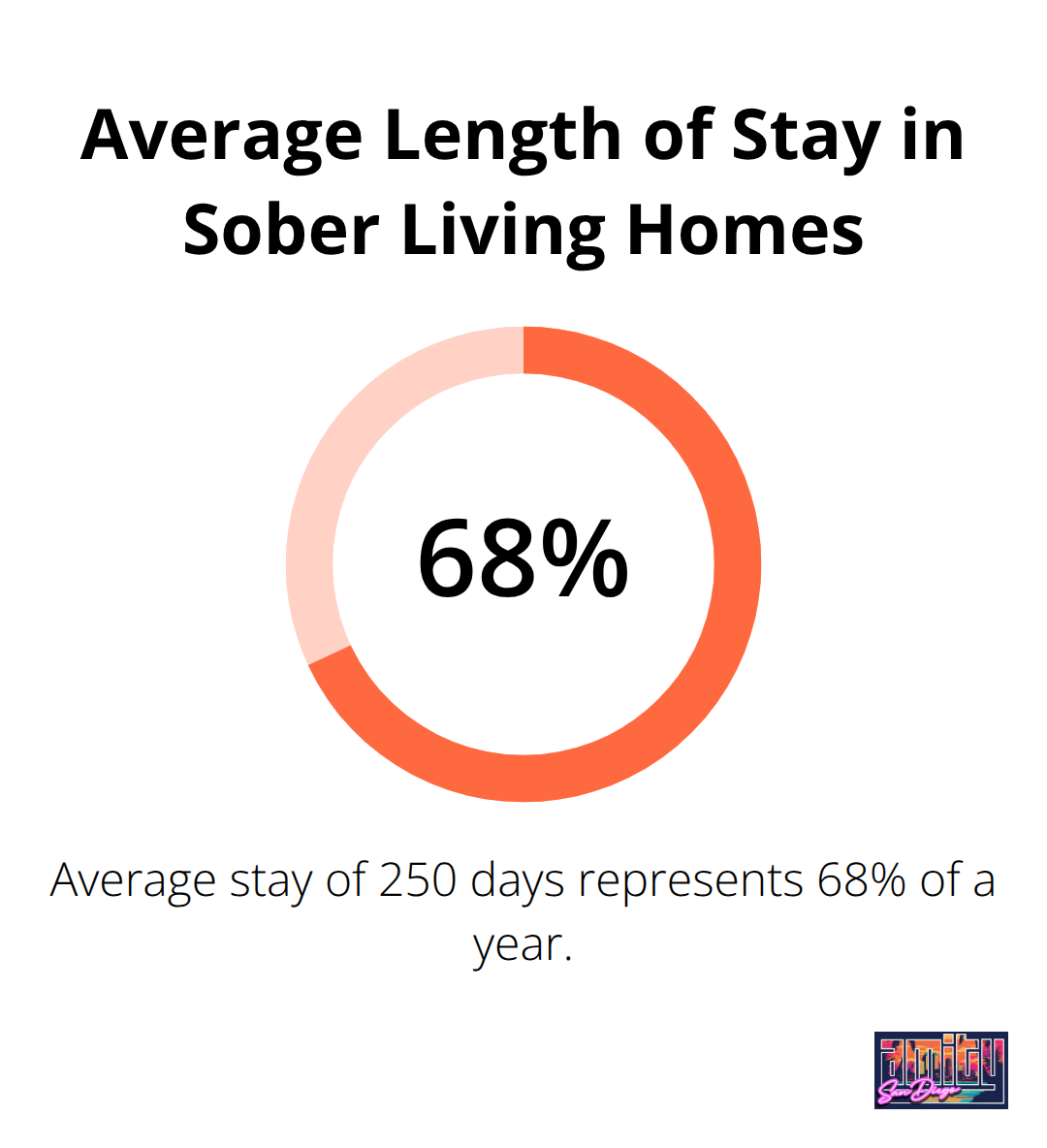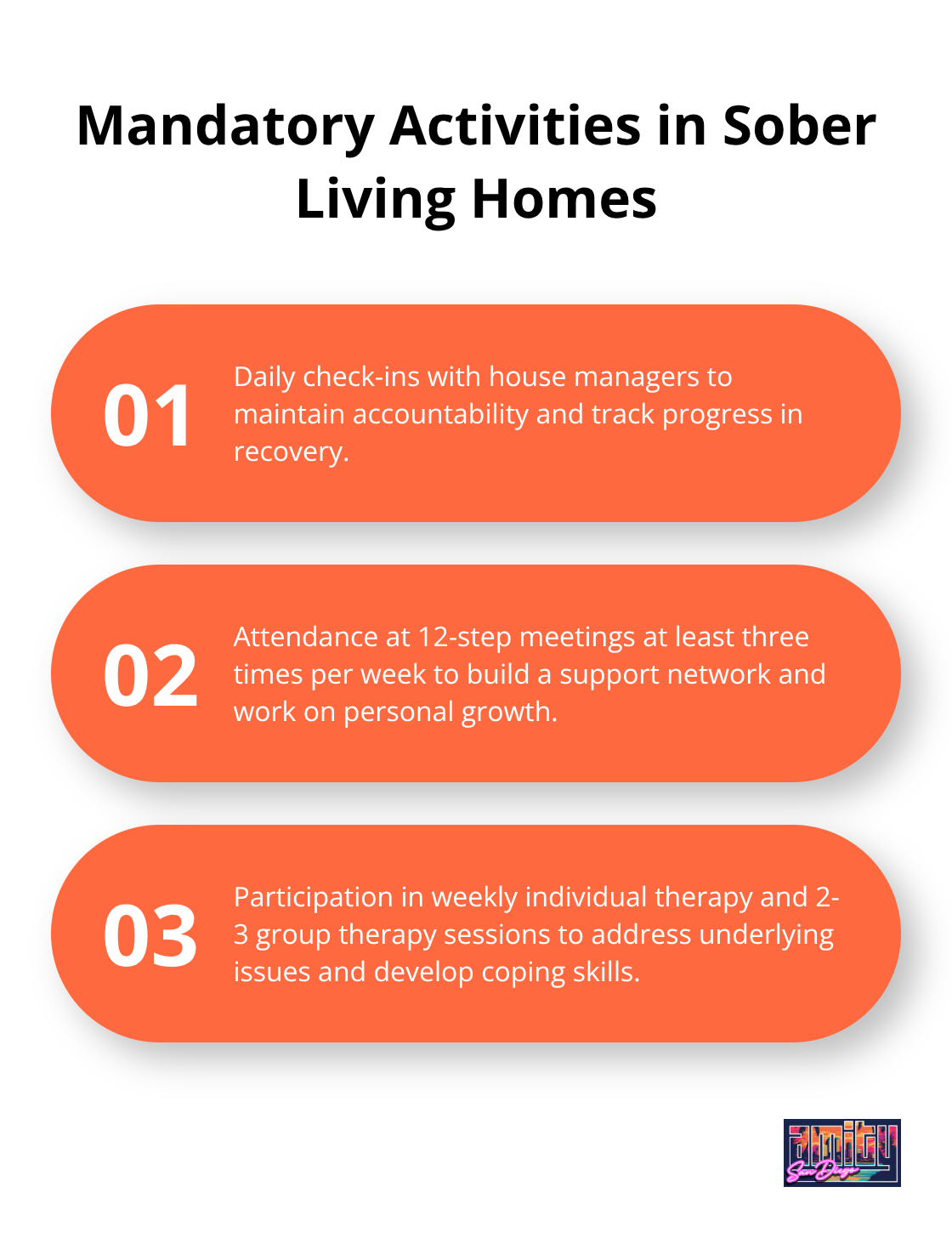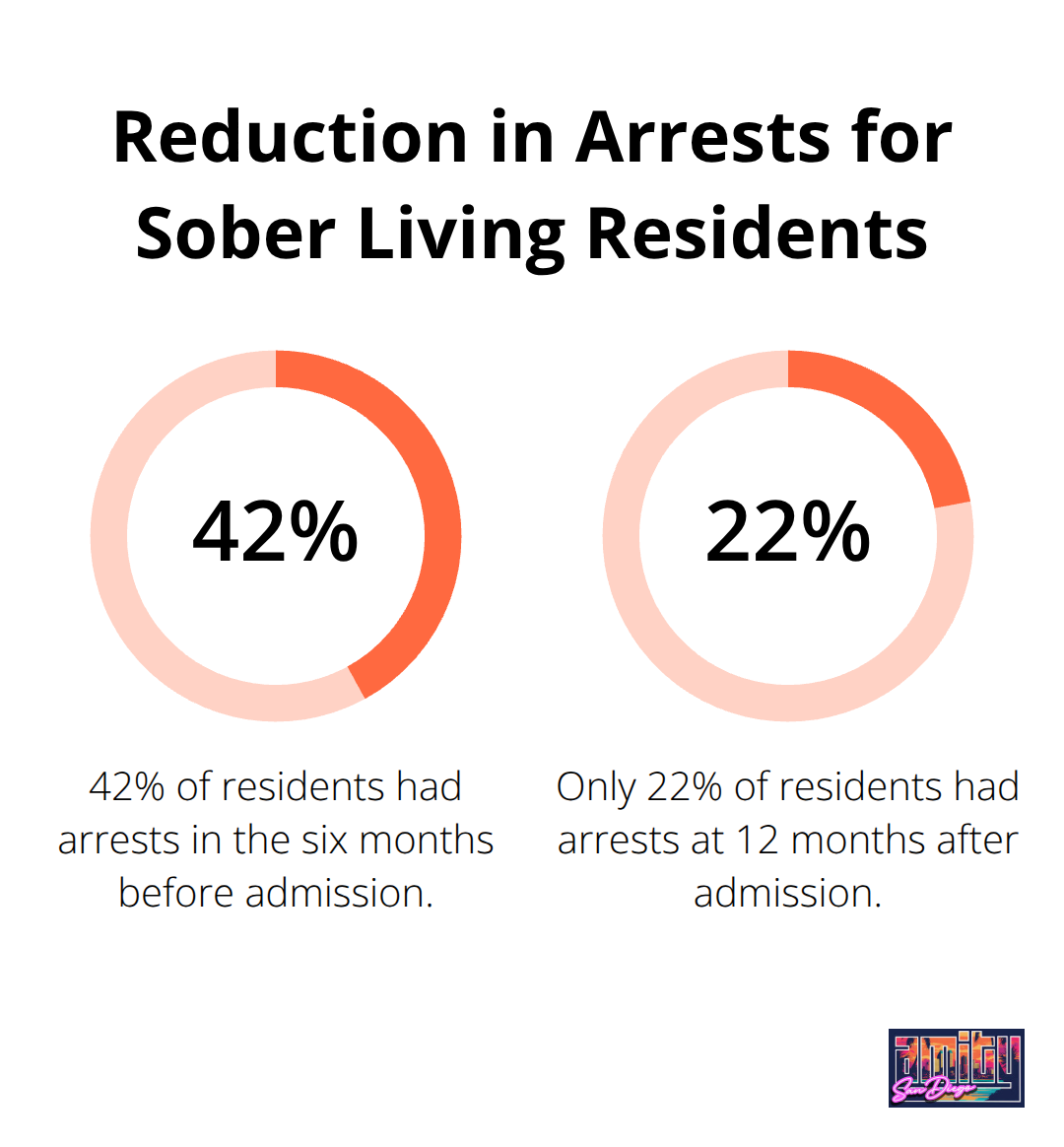Recovery from addiction requires structured support beyond initial treatment. Many people transitioning from rehab programs need a stable environment that bridges the gap between intensive care and independent living.
We at Amity San Diego understand that knowing what are sober living homes and how they function can help individuals make informed decisions about their recovery journey. These residential facilities provide the accountability and community support that research shows increases long-term sobriety success rates.
What Are Sober Living Homes
Drug-Free Residential Communities for Recovery
Sober living homes are structured residential facilities that provide drug and alcohol-free environments for individuals who recover from substance use disorders. These homes operate as transitional housing between intensive addiction treatment and independent living. They offer residents time to practice sobriety skills in a real-world setting.
The National Association of Recovery Residences categorizes sober living into four levels based on supervision and services provided. Level one facilities are peer-run with minimal structure, while level four homes offer on-site clinical services and professional staff. Research from the Alcohol Treatment Quarterly shows that residents in sober living programs demonstrate improved mental health and employment rates after 18 months compared to those without structured support.
Who Needs Sober Living Support
Sober living homes serve individuals who have completed primary addiction treatment programs, people who leave correctional facilities, and those who experience housing instability during recovery. The Substance Abuse and Mental Health Services Administration reports that individuals in recovery face relapse challenges, which makes supportive environments essential for maintaining sobriety.
Young adults who transition from treatment programs benefit significantly from peer accountability and structured living arrangements. Justice-involved individuals represent nearly one-third of sober living residents according to studies from the Alcohol Research Group. People who return to environments that threaten their sobriety find these homes provide the stability needed to rebuild their lives while they develop healthy coping mechanisms and support networks.
Cost and Length of Stay Considerations
Monthly costs for sober living range from $500 to $2,500 (depending on location, amenities, and level of supervision required). Average stays exceed 250 days at facilities like Options Recovery Services, which provides extended support for recovery benefits.

Residents typically contribute to household expenses through employment or family support, which makes financial planning an important component of the recovery process. The investment proves worthwhile as research demonstrates that longer stays correlate with better long-term outcomes and reduced relapse rates. For comprehensive addiction treatment San Diego residents can access additional resources.
How These Homes Function Daily
These residential communities operate through structured daily routines that residents must follow consistently. House managers oversee operations and maintain accountability systems that track resident progress and compliance with established rules.
How Sober Living Homes Operate
Daily Structure and Mandatory Routines
Sober living homes establish rigid daily structures that residents must follow without exception. Residents wake at designated times (typically 6-7 AM), attend mandatory house meetings, complete assigned chores, and maintain strict curfews that range from 9 PM to 11 PM depending on the facility. Random drug screenings occur weekly or bi-weekly, with immediate discharge for positive results.
House managers conduct daily check-ins with residents and track attendance at required 12-step meetings. Most facilities require residents to attend these meetings at least three times weekly. This structured approach creates predictable routines that help residents develop healthy habits and maintain accountability throughout their recovery process.

Peer Support and Accountability Systems
The peer accountability system functions through mandatory weekly house meetings where residents discuss challenges, celebrate milestones, and address rule violations collectively. Residents report on each other’s behavior, which creates a self-policing environment that provides essential peer support for recovery outside the context of treatment.
Each resident receives a sponsor or accountability partner who monitors daily activities and provides immediate intervention when warning signs appear. Violation consequences escalate from additional chores to extended curfews, with three strikes typically resulting in discharge from the program. This peer-driven approach builds strong support networks that extend beyond the residential period.
Integration with Treatment Programs
Sober living homes mandate participation in outpatient treatment programs, with residents attending individual therapy sessions weekly and group therapy sessions 2-3 times per week. Facilities coordinate directly with treatment providers to track attendance and progress, sharing information about resident compliance and behavioral changes.
Employment or educational activities become mandatory after the first 30 days (with residents required to demonstrate financial responsibility through job searches or vocational training programs). This comprehensive integration addresses both immediate housing needs and long-term recovery planning. While these structured environments provide essential support, residents often face significant challenges that can impact their success in recovery programs. For those seeking comprehensive addiction treatment San Diego offers various resources and facilities to support recovery.
Benefits and Challenges of Sober Living
Proven Recovery Advantages
Sober living homes produce measurable improvements in recovery outcomes that far exceed traditional approaches. Research shows that staying longer than six months in sober living houses is related to better abstinence outcomes. Residents at Options Recovery Services maintained average stays of 250 days, well above recommended durations for recovery benefits.
Employment rates increase dramatically for sober living residents. Research shows participants experience higher employment rates and reduced arrest frequencies, with Clean and Sober Transitional Living residents who saw arrests drop from 42% in the six months before admission to 22% at 12 months. The structured environment provides time to develop job skills, complete education programs, and establish financial stability while residents maintain sobriety.

Financial Barriers That Block Progress
Financial pressure creates the biggest challenge for most residents. Monthly costs that range from $500 to $2,500 strain budgets, especially when combined with outpatient treatment expenses and basic costs. Many residents struggle to maintain employment while they attend mandatory sessions and treatment programs, which creates a cycle where they cannot afford to stay but cannot afford to leave.
Social and Emotional Obstacles
Social isolation from old friend groups causes significant emotional distress for many residents. The requirement to abandon previous social circles while residents build new sober relationships leaves people who feel lonely and disconnected. House conflicts arise frequently in shared spaces, particularly around chore responsibilities, curfew enforcement, and different recovery philosophies among residents.
Long-Term Success Statistics
Follow-up studies demonstrate sustained improvements even after residents leave structured facilities. Research on sober living programs shows positive outcomes for alcohol and drug dependence treatment. Emotional and psychiatric symptoms showed consistent improvement throughout residency periods, with benefits that persist long-term.
For those seeking comprehensive support, consider exploring addiction treatment San Diego options that complement sober living arrangements.
Final Thoughts
Research demonstrates that sober living homes provide the structured support necessary for successful recovery transitions. These facilities offer accountability and peer support that consistently improves long-term sobriety outcomes. Data shows residents who stay longer than six months achieve better abstinence rates, while employment and mental health improvements persist after they leave these facilities.
Selecting the right program requires you to evaluate your specific needs, financial resources, and recovery goals. Consider the level of supervision required, proximity to treatment providers, and house rules that align with your recovery approach. Visit potential facilities, speak with current residents, and verify their connection with outpatient programs.
Those ready to take this important step should contact treatment professionals who can assess their situation and recommend appropriate facilities. We at Amity San Diego provide comprehensive outpatient programs that work with sober living arrangements (offering clinical support and personalized care that makes recovery sustainable). Your path toward lasting sobriety starts when you make informed decisions about what are sober living homes and the support systems that will guide your recovery forward.

